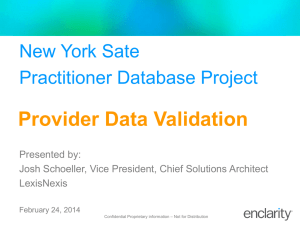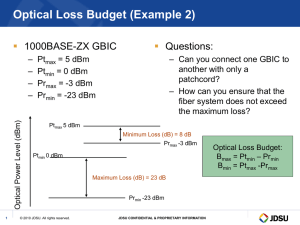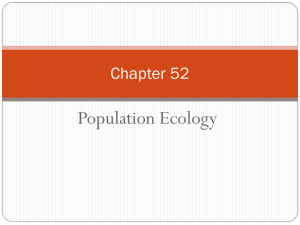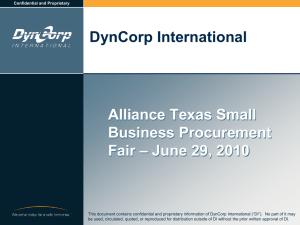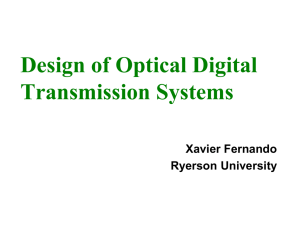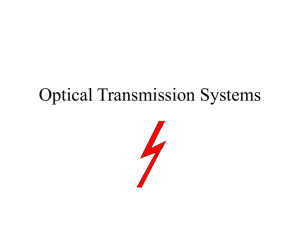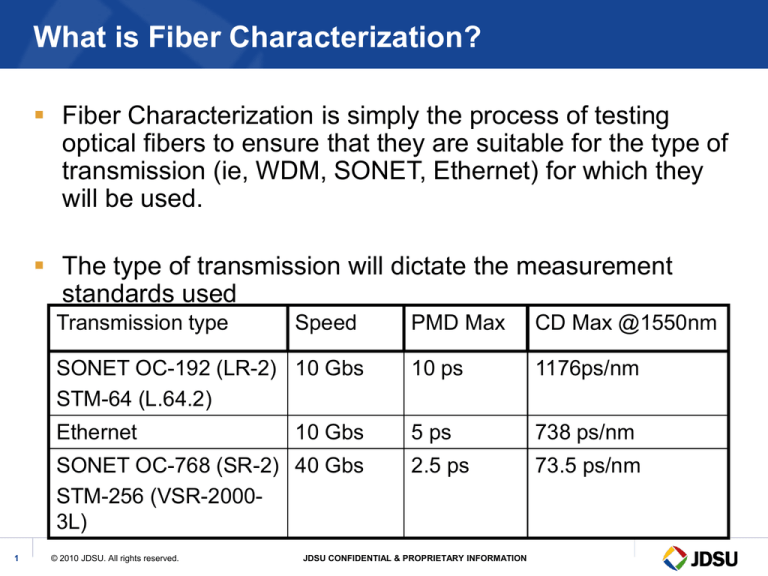
What is Fiber Characterization?
Fiber Characterization is simply the process of testing
optical fibers to ensure that they are suitable for the type of
transmission (ie, WDM, SONET, Ethernet) for which they
will be used.
The type of transmission will dictate the measurement
standards used
Transmission type
Speed
PMD Max
CD Max @1550nm
SONET OC-192 (LR-2) 10 Gbs
STM-64 (L.64.2)
10 ps
1176ps/nm
Ethernet
5 ps
738 ps/nm
2.5 ps
73.5 ps/nm
10 Gbs
SONET OC-768 (SR-2) 40 Gbs
STM-256 (VSR-20003L)
1
© 2010 JDSU. All rights reserved.
JDSU CONFIDENTIAL & PROPRIETARY INFORMATION
Insertion Loss (IL)
Also called span loss testing
Insertion Loss or Span Loss Testing
The most important test to be performed, as each
combination of transmitter/receiver has a power range limit.
ILProvides the most accurate end-to-end loss measurement
of fiber optic link including end connectors.
An IL measurement requires a calibrated source and a
power meter. The source sends a signal at a given power
level, and the power meter reads the remaining power level
at the far end of the link.
This is a unidirectional measurement, however performed
bi-directionally for operation purposes
3
© 2010 JDSU. All rights reserved.
JDSU CONFIDENTIAL & PROPRIETARY INFORMATION
Reference and Test Procedure
A 2-step operation
Step 1: Reference power level: Quantify the output power including the
fiber jumpers. Connect source and power meter together with the
jumpers.
Calibrated
light source
Test jumpers
Power Meter
Step2: Insert the fiber under test and the power measurement of the
connected elements (jumpers + fiber under test).
Test jumper #1 Fibre under test Test jumper #2
Calibrated
light source
4
© 2010 JDSU. All rights reserved.
Total attenuation of the link
JDSU CONFIDENTIAL & PROPRIETARY INFORMATION
Power Meter
Optical Return loss (ORL)
Optical Return Loss
The optical return loss (ORL) represents the portion of light reflected
back to the transmitter by the link components (connectors…) and the
fiber itself.
PAPC
PPC
Pelement
PAPC
PR
Transmitt
er
(Tx)
Receiver
(Rx)
PBS
PBS
PBS
PT
The 2 predominant test methods:
– Optical Continuous Wave Reflectometry (OCWR)
• A laser source and a power meter, using the same test port, are connected to the
fiber under test.
– Optical Time Domain Reflectometry (OTDR)
• The OTDR is able to measure not only the total ORL of the link but also section
ORL (cursor A – B)
Excess ORL can cause high BER due to transmitter instability and/or
noise at the receiver via Multi-path Interference (MPI).
6
© 2010 JDSU. All rights reserved.
JDSU CONFIDENTIAL & PROPRIETARY INFORMATION
Polarization Mode Dispersion
(PMD)
State of Polarization (SOP)
Slow Axis
PSP
Fast Axis
Polarization Mode (PSP)
The polarization eigenmodes are
represented as two propagation axes,
called PSP : Principal States of
Polarization.
8
© 2010 JDSU. All rights reserved.
JDSU CONFIDENTIAL & PROPRIETARY INFORMATION
Polarized optical
signal
(vector sum of the
polarization modes)
Polarization Mode (PSP)
Polarization Mode Dispersion - The Causes No perfect fiber circularity and symmetry (birefringence)
o the group velocities of the PSPs are slightly different inducing PMD.
Fiber stress and in-homogeneity ( e.g. bends… ) create local
birefringence, inducing coupling between the PSPs.
o A real fiber is a randomly distribution addition of these local birefringence sections
Local bi-refringence sections in a fiber
Light launched into a fiber with a given state of polarization
(SOP) changes its SOP along the way in a slowly time-varying
random process ( i.e. unpredictable) .
9
© 2010 JDSU. All rights reserved.
JDSU CONFIDENTIAL & PROPRIETARY INFORMATION
Why does PMD appears ?
Fiber optic cables which have been deployed in the
outside plant are not perfect.
Manufacturing defects.
– The fiber core is not perfectly circular along its overall
length
– The fiber core is not perfectly concentric with the
cladding
– The fiber can be twisted, tapered, or bent at some points
along the span.
10
© 2010 JDSU. All rights reserved.
JDSU CONFIDENTIAL & PROPRIETARY INFORMATION
Differential Group Delay
Different polarization modes travel at different velocities
presenting a different propagation time between the
two modes (PSPs).
The resulting difference in propagation time between
polarization modes is called Differential Group Delay
(DGD).
V1 > V2
DGD
v2
v1
Perfect SM Fiber span
11
© 2010 JDSU. All rights reserved.
JDSU CONFIDENTIAL & PROPRIETARY INFORMATION
Strong Mode coupling
Separated polarisation modes interact with each other: PSPs are
changing randomly (External constraints (stress, bending, twisting),
Temperature…)
DGD
v2
Fast
Slow
v1
12
© 2010 JDSU. All rights reserved.
JDSU CONFIDENTIAL & PROPRIETARY INFORMATION
Polarization Mode Dispersion - The phenomenon Interaction between light and material properties: SOP vs
birefringence
PMD is the average value of the Differential Group Delay
(mean DGD), so called PMD delay [ps], expressed by the
PMD delay coefficient c [ps/km]
=
L c
Instantaneous PMD varies with , time, T°, movement.
PMD is not intrinsic and requires statistical predictions
– PMD fluctuates over the network life cycle
13
© 2010 JDSU. All rights reserved.
JDSU CONFIDENTIAL & PROPRIETARY INFORMATION
Polarization Mode Dispersion - The Issues PMD constraints increase with:
– Channel Bit rate
– Fiber length (number of sections)
– Number of channels (increase missing channel
possibility)
PMD decreases with:
– Better fiber manufacturing control (fiber geometry…)
– PMD compensation modules
PMD is more an issues for old G652 fibers (<1996)
than newer G652, G653, G655 fibers
At any given signal wavelength the PMD is
an unstable phenomenon, unpredictable.
14
© 2010 JDSU. All rights reserved.
JDSU CONFIDENTIAL & PROPRIETARY INFORMATION
PMD – Limiting Transmission Parameter -
PMD tolerance for NRZ
transmission with 1dB
power penalty
15
© 2010 JDSU. All rights reserved.
Bit
PMD
rate/channel Tolerance
(Gbit/s)
2.5Gbit/s
40ps
10Gbit/s
10ps
40Gbit/s
2.5ps
JDSU CONFIDENTIAL & PROPRIETARY INFORMATION
10 Gig Ethernet transmission Limits
As defined by the IEEE 802.3ae-2002 standard,
tolerances for dispersion are much lower than
Sonet/SDH.
Bit rate/channel
PMD Tolerance
10GEth
5 ps
2 principle constraints
– Forward Error Correction is not robust to CD impact
– Acceptable outage probability is lower
• 10-7 for 10Gig Ethernet vs 10-5 for SDH/SONET
16
© 2010 JDSU. All rights reserved.
JDSU CONFIDENTIAL & PROPRIETARY INFORMATION
When Measuring PMD?
PMD is created or affected at different stages of
the network deployment and must be measured
– During the fiber manufacturing process (plant)
– During the cable manufacturing process (plant)
– After installation of the cable for very high bit rate (field)
• 10 Gbit/s per channel or above
– At the planning to upgrade an existing network (field)
• Fiber manufactured before <1990 have to be verified
– Regularly during the network life (environmental
conditions)
– Additional service to be offered by installers
17
© 2010 JDSU. All rights reserved.
JDSU CONFIDENTIAL & PROPRIETARY INFORMATION
PMD Testing - Equipment Overview
The broadband source sends a polarized light which is
analyzed by a spectrum analyzer after passing through a
polarizer
PMD measurement is typically performed
unidirectional.
or
with
T-BERD 8000 platform
ODM plug-in module
handheld OBS-5x0 BBS2A plug-in module
When PMD results are too close to the system limits, it may be required
to perform a long term measurement analysis in order to get a better
picture of the variation over the time.
18
© 2010 JDSU. All rights reserved.
JDSU CONFIDENTIAL & PROPRIETARY INFORMATION
PMD Testing – Equipment Setup
Measurement acquisition
– Set the Broadband source mode to « PMD »
– No other specific test setup, except distance…
– Press
and the Start the measurement
– Between 6s and 12s depending on the fiber length
Fiber under Test
19
© 2010 JDSU. All rights reserved.
JDSU CONFIDENTIAL & PROPRIETARY INFORMATION
PMD Testing – Results Graph
FFT and
associated
Gaussian
graphical display
Pass/Fail
indication if
threshold setup
Results and
setting
parameters
automatically
saved
21
© 2010 JDSU. All rights reserved.
JDSU CONFIDENTIAL & PROPRIETARY INFORMATION
PMD Testing – File Saving/Printing
Measurement is
automatically saved in the
hard disk with the
associated date/time.
Autonaming setup or
manual naming of traces is
available if desired
Link Manager enables to
get access to a quick
overview of the test results
22
© 2010 JDSU. All rights reserved.
JDSU CONFIDENTIAL & PROPRIETARY INFORMATION
Chromatic Dispersion (CD)
Chromatic Dispersion - The Definition Effect that different wavelengths (colors or spectral
components of light) travel at different speed in a
media (Fiber for ex.)
– In telecommunications, an optical pulse is composed by
multiple wavelengths which travel at different speeds.
– In DWDM transmission, each wavelength/frequency
(each color) travels at a different speed.
It depends on the spectral quality of the source and
its modulation scheme
propagation delay time due to the variation of index
according to the wavelength
24
© 2010 JDSU. All rights reserved.
JDSU CONFIDENTIAL & PROPRIETARY INFORMATION
Chromatic Dispersion – The Parameters Chromatic Dispersion (CD) is measured in ps/(nm.km) and is the pulse
(or group) delay (ps) of a wavelength variation of one nanometer (nm),
over one km.
– The chromatic dispersion value is provided at a given wavelength.
– It can be positive (shorter wavelengths travelling faster) or negative (longer
wavelengths travelling faster).
The zero dispersion wavelength value: 0 , in nm
The dispersion slope (S) describes the amount of CD change for
different wavelengths
– It is expressed in ps/(nm2.km)
– The slope along the 0 wavelength: S0 , in ps/(nm2.km)
Intrinsic fiber parameter but varies with fiber type.
25
© 2010 JDSU. All rights reserved.
JDSU CONFIDENTIAL & PROPRIETARY INFORMATION
Zero dispersion wavelength
Wavelength where the Dispersion is null.
Operating at this wavelength does not exhibit
Chromatic dispersion
gives this
zero dispersion wavelength
© 2010 JDSU. All rights reserved.
_
(nm)
26
+
Chromatic Dispersion
(ps/nm-km)
Pulse delay (ps)
The slope of this
(nm)
zero dispersion wavelength
JDSU CONFIDENTIAL & PROPRIETARY INFORMATION
Chromatic dispersion – The causes Material
dispersion
Total Chromatic
Dispersion
2
0
Dispersion (ps/nm.km)
20
1
0
1290nm
0
1310nm
10
-20
Waveguide
Dispersion
120
0
130
0
140
0
150
0
(nm)
Core refractive
index
Material dispersion
Waveguide dispersion
27
© 2010 JDSU. All rights reserved.
Index profile and MFD
JDSU CONFIDENTIAL & PROPRIETARY INFORMATION
Chromatic Dispersion – The Phenomenon At the end the pulse
is larger
The pulse spectrum has
a width
Chromatic
Dispersion
Blue
Transmission starting
5
28
Transmission ending
1
2
3
4
© 2010 JDSU. All rights reserved.
Red
JDSU CONFIDENTIAL & PROPRIETARY INFORMATION
Chromatic Dispersion – Fiber parameter CD Value
(ps/nm.km)
40
G652 Standard SMF
( Unshifted Dispersion)
30
G656 Non-Zero Dispersion
for Wideband Transport
20
G655 Non Zero Disp.
Shifted SMF
10
0
1000
29
G653 Dispersion
Shifted SMF
1100
© 2010 JDSU. All rights reserved.
1200
1310
1400
1500
1600
JDSU CONFIDENTIAL & PROPRIETARY INFORMATION
Wavelength (nm)
Chromatic Dispersion – Fiber Classification -
ITU-T Fiber
Type
G.652
description
Zero wavelength
Dispersion at
1550nm
Non Dispersion
Shifted Fiber
1310 – 1324 nm
17 ps/nm.km
0.057 ps/nm².km
G.653
Dispersion Shifted
Fiber
1500 – 1600 nm
0 ps/nm.km
0.07 ps/nm².km
G.655
Non zero
Not specified but
Dispersion Shifted ~1450-1480 nm
Fiber
Negative Non zero
dispersion shifted
fiber
Wide band NZDSF
???
4 ps/nm.km
0.045 to 0.1
ps/nm².km
-5ps/nm.km
0.05 to 0.12
ps/nm².km
G.656
30
© 2010 JDSU. All rights reserved.
8 ps/nm.km
JDSU CONFIDENTIAL & PROPRIETARY INFORMATION
Dispersion slope
@1550nm
Chromatic Dispersion - The Effects The variation of index according to the wavelength
induces a pulse width variation and may
consequently cause it to interfere with neighboring
pulses. It also reduces the pulse peak power.
It limits the transmission speed of the networks
It limits the transmission distance of the networks
It puts limits on DWDM due to relation with FWM,
but this can be optimized
31
© 2010 JDSU. All rights reserved.
JDSU CONFIDENTIAL & PROPRIETARY INFORMATION
Communication Tolerance to CD
32
© 2010 JDSU. All rights reserved.
JDSU CONFIDENTIAL & PROPRIETARY INFORMATION
Chromatic Dispersion – Limiting Transmission Parameter -
CD tolerance for NRZ
transmission with 1dB
power penalty
Bit
Chromatic
rate/channel Dispersion
(Gbit/s)
Tolerance @
1550nm
2.5Gbit/s
18.81ns/nm
Dispersion related system
10Gbit/s
power penalty is generaly of
1dB max.
40Gbit/s
33
© 2010 JDSU. All rights reserved.
JDSU CONFIDENTIAL & PROPRIETARY INFORMATION
1176ps/nm
73.5ps/nm
10 Gig Ethernet transmission Limits
As defined by the IEEE 802.3ae-2002 standard,
tolerances for dispersion are much lower than
Sonet/SDH.
Bit rate/channel
Chromatic
Dispersion
Tolerance @
1550nm
10GEth
738 ps/nm
2 principle constraints
– Forward Error Correction is not robust to CD impact
– Acceptable outage probability is lower
• 10-7 for 10Gig Ethernet vs 10-5 for SDH/SONET
34
© 2010 JDSU. All rights reserved.
JDSU CONFIDENTIAL & PROPRIETARY INFORMATION
How far can I go without dispersion
compensation?
Distance (Km) = Specification of Transponder (ps/nm)
Coef.of Dispersion of Fiber (ps/nm*km)
A receiver with dispersion tolerance of 3400 ps/nm is sent across a
standard SMF-28 fiber which has a Coefficient of Dispersion of 17
ps/nm*km.
It will reach 200 Km at maximum bandwidth.
(Note that lower speeds will travel farther.)
35
© 2010 JDSU. All rights reserved.
JDSU CONFIDENTIAL & PROPRIETARY INFORMATION
Dealing with Chromatic Dispersion
These parameters can be controlled in such way to
control the material dispersion:
–
–
–
–
–
36
Using of fiber which has minimum dispersion.
Selecting a low chirp source
Using external modulator
Using electronic regenerator (high cost).
Using dispersion compensation.
© 2010 JDSU. All rights reserved.
JDSU CONFIDENTIAL & PROPRIETARY INFORMATION
Chromatic Dispersion – Equipment Overview
The CD test set consists of a broadband light source (transmitter) and a
phase meter (receiver) connected at each end of the fiber under test.
The receiver measures the broadband signal in user defined increments
(such as10 nm increments). Approximation formula is then applied in
order to calculate the dispersion over a given wavelength range.
CD measurement is typically performed unidirectional.
or
with
T-BERD 8000 platform
ODM plug-in module
handheld OBS-5x0 BBS2A plug-in module
The results will be correlated to the transmission system limits
according to the bit rate being implemented.
37
© 2010 JDSU. All rights reserved.
JDSU CONFIDENTIAL & PROPRIETARY INFORMATION
Chromatic Dispersion Testing – Equipment Setup
1.
Source referencing
–
To be performed in order to calibrate the receiver with the
Broadband Source
•
–
–
–
2.
At the early begining of a measurement campaign
Connect the test jumpers to the source and the ODM
module
In the CD Setup page, Press the soft key « Acq. Ref »,
select Yes to perform a new reference, enter the source
serial number and confirm.
A green « valid reference » indicator will be displayed at
the end of the reference acqusition.
Measurement acquisition
–
–
–
Connect both instruments at each end of the fiber under test using the calibrated test jumpers.
Press
to perform the acqusition
Between 45s and 70s depending on the fiber length
Fiber under Test
38
© 2010 JDSU. All rights reserved.
JDSU CONFIDENTIAL & PROPRIETARY INFORMATION
Chromatic Dispersion Testing – Results Graph
Dispersion curve
Zero dispersion wavelength and slope
CD value vs. wavelength:
–
Total link dispersion per wavelength
– Dispersion slope
The Chromatic dispersion measurement will be performed over a given
wavelength range and results will be correlated to the transmission system
limits according to the bit rate being implemented.
40
© 2010 JDSU. All rights reserved.
JDSU CONFIDENTIAL & PROPRIETARY INFORMATION
Chromatic Dispersion Testing – File
Saving/Printing
Measurement is
automatically saved in
the hard disk with the
associated date/time.
Autonaming setup or
manual naming of traces
is available if desired
Link Manager enables to
get access to a quick
overview of the test
results
41
© 2010 JDSU. All rights reserved.
JDSU CONFIDENTIAL & PROPRIETARY INFORMATION
Attenuation profile (AP)
Fiber Attenuation vs. Wavelength
Attenuation depends on the fiber type and the wavelength. If the
absorption spectrum of a fiber is plotted against the wavelength of the
laser, certain characteristics of the fiber can be identified.
The graph in Figure 2 illustrates the relationship between the
wavelength of the injected light and the total fiber attenuation.
43
© 2010 JDSU. All rights reserved.
JDSU CONFIDENTIAL & PROPRIETARY INFORMATION
Why measuring Attenuation Profile of a fiber?
The purpose of the AP measurement is to represent the
attenuation as a function of the wavelength.
Historically, this measurement was required mainly for longhaul applications. Meanwhile, with the increase of CWDM
deployment and the extension of the DWDM wavelength
range, it is becoming necessary to have a clear picture of
the fiber attenuation other the wavelengths intended to be
filled-in with traffic.
44
© 2010 JDSU. All rights reserved.
JDSU CONFIDENTIAL & PROPRIETARY INFORMATION
Characterizing the full wavelength range
In long distance transmissions, as well as at very
high bit rate (10G, 40G systems), Raman
amplifications are more and more in use. In
addition, new Distal pumping of Erbium amplifiers
at 1480 nm are currently deployed. Characterizing
fiber at the pump wavelengths (1420, 1450 nm,
1480 nm, etc.) is of high interest to ensure
amplification will occur along the required distance.
Because all of these applications make such a
broad and varied use of the optical fiber,
characterization over the complete useful
wavelength is justified rather than characterizing
only at discrete wavelengths.
45
© 2010 JDSU. All rights reserved.
JDSU CONFIDENTIAL & PROPRIETARY INFORMATION
Attenuation Profile
An AP test set consists of a broadband light source
(transmitter) and a spectrum analyzer (receiver). The
broadband source sends light, with a given wavelength
range, into the fiber under test, which is analyzed by the
spectrum analyzer at the far end.
or
with
T-BERD 8000 platform
ODM plug-in module
handheld OBS-5x0 BBS2A plug-in module
Every fiber presents varying levels of attenuation across the transmission spectrum.
The purpose of the AP measurement is to represent the attenuation as a function of
the wavelength.
46
© 2010 JDSU. All rights reserved.
JDSU CONFIDENTIAL & PROPRIETARY INFORMATION
Attenuation Profile Testing – Equipment Setup
1.
Source referencing
–
To be performed in order to measure the
Broadband Source output power with test jumpers
•
•
–
–
2.
At the early begining of a measurement campaign
Each time jumpers are changed/disconnected
Connect the test jumpers to the source and the
ODM module
In the AP Setup page, Press the soft key « Acq.
Ref », select Yes to perform a new reference,
enter the source serial number and confirm.
Measurement acquisition
–
–
–
Set the Broadband source mode to « AP »
No specific test setup, except distance…Just press Start !
After 12s max.
Fiber under Test
47
© 2010 JDSU. All rights reserved.
JDSU CONFIDENTIAL & PROPRIETARY INFORMATION
Attenuation Profile Testing – Results Graph
Attenuation profile
curve
Loss value vs. wavelength:
–Coefficient (dB/km)
–Total link loss per wavelength
(dB)
48
© 2010 JDSU. All rights reserved.
JDSU CONFIDENTIAL & PROPRIETARY INFORMATION
Attenuation Profile Testing – File Saving/Printing
Measurement is
automatically saved in
the hard disk with the
associated date/time.
Autonaming setup or
manual naming of traces
is available if desired
Link Manager enables to
get access to a quick
overview of the test
results
49
© 2010 JDSU. All rights reserved.
JDSU CONFIDENTIAL & PROPRIETARY INFORMATION
Data Recording Process
50
© 2010 JDSU. All rights reserved.
JDSU CONFIDENTIAL & PROPRIETARY INFORMATION
Thank You….

